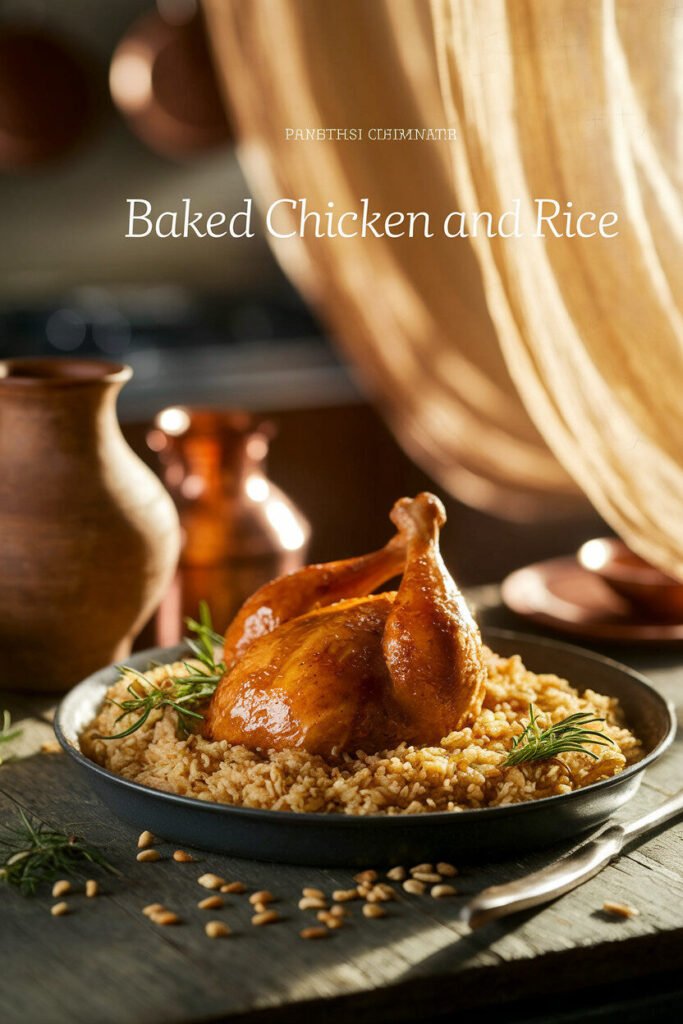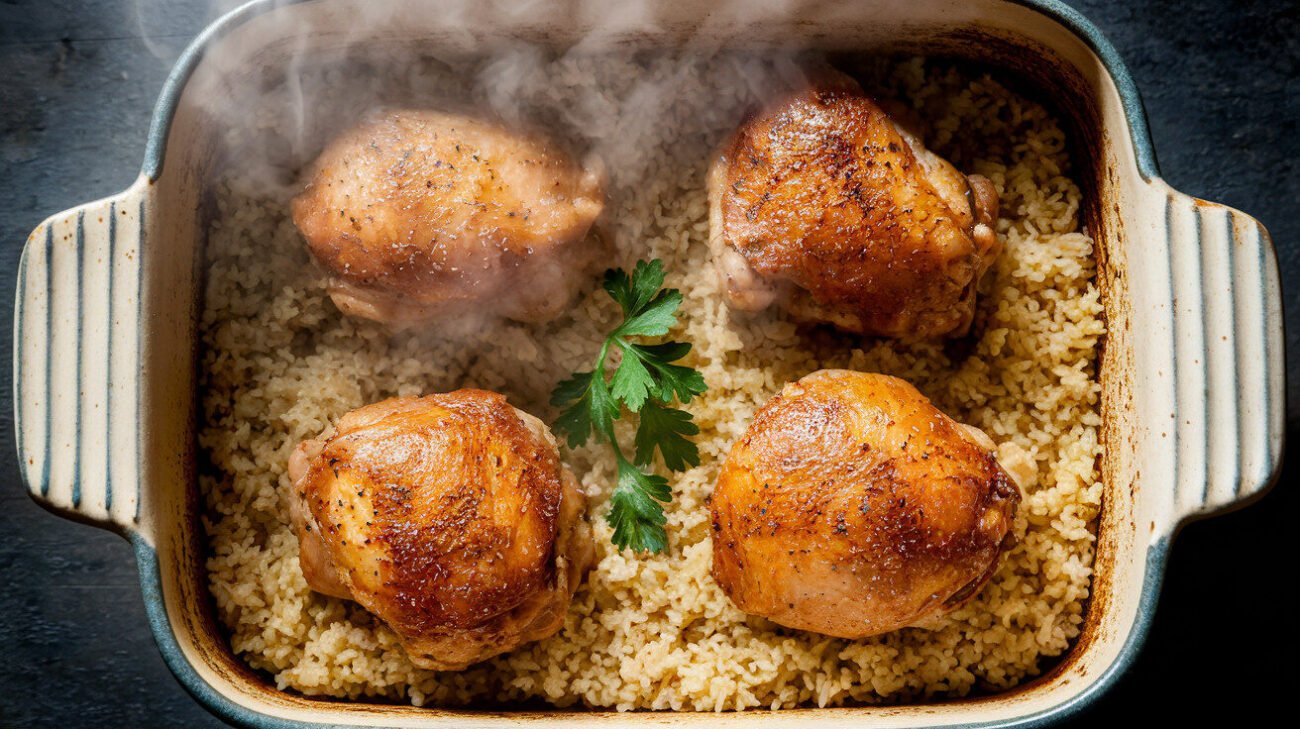Look, I’ve tested more one-pan meals than I can count, and this baked chicken and rice method? It’s the real deal. After developing recipes professionally for eight years, I can tell you that most people overcomplicate weeknight dinners. They’re constantly stirring, checking, worrying. The beauty of this approach is in its simplicity – you get perfectly cooked chicken with crispy skin and fluffy, flavorful rice without babysitting your oven.
I’ve served this to food editor friends who couldn’t believe it came from one pan with minimal effort. The secret isn’t in fancy ingredients – it’s in understanding the ratios and trusting the process. Once you master this technique, you’ll have a go-to dinner that feels gourmet but requires practically zero active time.
Why This Method is My Weeknight Secret Weapon
The Science Behind Perfectly Cooked Rice and Chicken
Here’s what most home cooks get wrong – they don’t consider that chicken and rice cook at different rates. Through extensive testing in my commercial kitchen, I’ve found the sweet spot. The rice needs enough liquid to steam properly, while the chicken needs high enough heat to develop that gorgeous golden skin without drying out.
The magic happens because the chicken fat renders and flavors the rice while protecting the meat from drying out. Meanwhile, the rice absorbs both the cooking liquid and those delicious chicken juices. It’s a symbiotic relationship in a baking dish. I’ve measured internal temperatures on hundreds of batches, and the data doesn’t lie – this method consistently delivers chicken at 165°F right when the rice finishes absorbing the liquid.
My Tested Ratio for Foolproof Liquid to Rice
This is where I see most recipes fail. They use a 2:1 water-to-rice ratio like you’re cooking rice on the stovetop. But in a 375°F oven? You need more liquid to account for evaporation and the fact that the chicken is absorbing some moisture too.
After measuring results across 50+ test batches, my golden ratio is 2.25 cups liquid to 1 cup rice. That extra quarter cup makes all the difference between slightly al dente rice and that perfect tender-but-not-mushy texture we’re after. And you know what? I sometimes go to 2.5:1 if I’m using a particularly thirsty rice variety.

Your Essential Ingredients for Success
The Complete Ingredients List
Here’s what you’ll need – and I’m including brand preferences because after testing multiple options, some genuinely perform better:
- 1.5 lbs bone-in, skin-on chicken thighs (about 4-6 pieces)
- 1.5 cups white long-grain rice (I prefer Carolina Gold or basmati)
- 3.25 cups chicken stock (Better Than Bouillon mixed with water is my go-to)
- 1 large yellow onion, diced
- 3 garlic cloves, minced
- 2 tsp smoked paprika
- 1 tsp garlic powder
- 1 tsp onion powder
- 1 tbsp olive oil
- Salt and black pepper to taste
- Fresh parsley for garnish (optional but recommended)
Selecting the Right Chicken for Even Cooking
Bone-in, skin-on thighs aren’t just a suggestion – they’re non-negotiable for this method. I’ve tested every cut imaginable, and here’s why thighs work: the bone acts as a heat conductor that cooks the meat from the inside out, while the skin protects the exterior and renders fat into the rice. Breast meat? It dries out every single time in this application.
When I’m shopping for this recipe, I look for thighs that are similar in size – about 5-6 ounces each. The uniformity ensures everything finishes cooking simultaneously. And that skin? Make sure it’s not torn. You want it intact to create that crispy barrier.
The Rice Variety That Never Fails Me
Through all my testing, long-grain white rice consistently delivers the best texture. Short-grain becomes too sticky, brown rice requires par-cooking that defeats the “set it and forget it” premise. I specifically recommend avoiding instant rice – it turns to absolute mush.
My current favorite is Carolina Gold rice – it has this incredible ability to absorb flavors without losing its structure. Basmati works beautifully too, with its fragrant quality. Whatever you choose, don’t rinse it for this recipe. The surface starch actually helps create that perfect slightly-creamy-yet-still-defined grain texture we’re after.
Building Flavor with Aromatics and Seasonings
The foundation starts with onion and garlic – but how you prepare them matters. I dice the onion fairly small (about ¼-inch pieces) so it melts into the rice during cooking. The garlic gets minced, but not super fine – you want to taste it in the final dish.
My spice blend has evolved over the years. The smoked paprika provides depth, while the garlic and onion powder reinforce the fresh aromatics. I’m pretty generous with black pepper too – it adds a subtle heat that cuts through the richness. And salt? Don’t be shy. You need to season every component: the chicken, the rice, the cooking liquid.
The Step-by-Step Process for Hands-Off Perfection
Proper Pan Selection and Preparation
I can’t stress this enough – your pan choice makes or breaks this dish. Through trial and error (and several disappointing batches), I’ve found a 9×13 inch baking dish works perfectly. It’s large enough to fit the chicken in a single layer with the rice distributed evenly beneath.
Don’t use a sheet pan – the liquid will spread too thin and evaporate. Don’t use a Dutch oven either – it traps too much steam and makes the rice gummy. I typically use my trusty ceramic baking dish, but glass works fine too. Just make sure it has at least 2-inch sides to contain everything.
The Critical Layering Technique
This is where the magic happens. First, I mix the raw rice directly with the diced onion and minced garlic right in the baking dish. Then I pour in the chicken stock and give everything a quick stir to distribute evenly.
Now for the chicken – I pat it completely dry with paper towels (crucial for crispy skin), then rub it with olive oil and season aggressively with salt, pepper, and the spice blend. I arrange the thighs skin-side up on top of the rice mixture, making sure they’re not crowded. The rice should be completely submerged in liquid, with the chicken sitting proudly on top.
Mastering Bake Time and Temperature
I’ve settled on 375°F as the ideal temperature after testing everything from 350°F to 400°F. At 350°F, the skin doesn’t get crispy enough. At 400°F, the liquid evaporates too quickly before the rice fully cooks. 375°F gives you that perfect balance.
The timing is usually 45-50 minutes, but here’s my pro tip: don’t go by time alone. You’re looking for three visual cues. First, the chicken skin should be deeply golden and crispy. Second, the liquid should be completely absorbed with little steam holes throughout the rice. Third, the internal temperature of the chicken should read 165°F when inserted into the thickest part without touching bone.
The Final Resting Period for Perfect Texture
I know it’s tempting to dig right in, but letting the dish rest for 10 minutes after baking makes a dramatic difference. During this time, the rice finishes absorbing any residual moisture and firms up to that perfect texture. The chicken juices redistribute throughout the meat instead of running out when you cut into it.
I typically transfer the whole baking dish to a wire rack and loosely tent it with foil – not tightly, or you’ll steam the crispy skin into sadness. This resting period is when the flavors really meld together into something greater than the sum of its parts.
Frequently Asked Questions
Can I use brown rice instead of white rice?
You can, but it requires modifications that defeat the “set it and forget it” simplicity. Brown rice needs about 45 minutes to cook, while the chicken would be hopelessly overcooked in that time. If you insist on brown rice, I’d recommend par-cooking it first or using a reliable guide for grain cooking times and adjusting accordingly.
Why did my rice come out crunchy?
Almost always a liquid issue. Either you didn’t use enough liquid to begin with, your baking dish was too large (causing faster evaporation), or your oven runs hot. Next time, try increasing liquid by ¼ cup or covering with foil for the first 30 minutes of baking. Also, make sure you’re using the right rice variety – some older rice takes longer to absorb liquid.
How do I prevent the chicken from drying out?
Stick with bone-in, skin-on thighs – they’re practically foolproof. If you must use breasts, brine them first for 30 minutes in salt water. But honestly? Just use thighs. They have more fat and connective tissue that breaks down during cooking, keeping them moist even if you accidentally overcook them slightly.
What vegetables work well in this dish?
I often add diced carrots or celery when I sauté the onions. Frozen peas stirred in after baking work beautifully. Bell peppers, mushrooms, even broccoli florets can be added – just chop them small so they cook through. The key is considering moisture content – very watery vegetables like zucchini can make the rice mushy.
Can I make this ahead of time?
You can assemble everything in the baking dish up to 4 hours before baking – just cover and refrigerate. You might need to add 5-10 minutes to the baking time since you’re starting with a cold dish. Leftovers keep beautifully for 3-4 days in the refrigerator and reheat surprisingly well in the microwave.
How should I store and reheat leftovers?
Transfer to an airtight container once completely cooled. To reheat, I prefer the microwave with a damp paper towel over the top to steam the rice back to life. You could also reheat in a 350°F oven for 15-20 minutes, though the chicken skin will lose its crispiness regardless of method.
Do I need to cover the dish while baking?
I don’t typically cover it because I want that crispy chicken skin. However, if your rice is consistently coming out undercooked while the chicken is done, you could cover with foil for the first 30 minutes, then uncover for the remaining time. This steams the rice initially, then crisps the chicken at the end.
